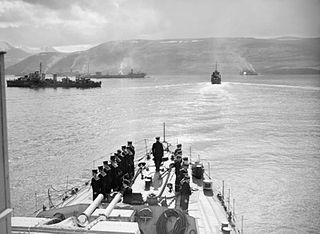
PQ 17 was the code name for an Allied Arctic convoy during the Second World War. On 27 June 1942, the ships sailed from Hvalfjörður, Iceland, for the port of Arkhangelsk in the Soviet Union. The convoy was located by German forces on 1 July, after which it was shadowed continuously and attacked. The First Sea Lord Admiral Dudley Pound, acting on information that German surface units, including the German battleship Tirpitz, were moving to intercept, ordered the covering force built around the Allied battleships HMS Duke of York and the USS Washington away from the convoy and told the convoy to scatter. Because of vacillation by Oberkommando der Wehrmacht, the Tirpitz raid never materialised. The convoy was the first large joint Anglo-American naval operation under British command; in Churchill's view this encouraged a more careful approach to fleet movements.

HMS Edinburgh was a Town-class light cruiser of the Royal Navy, which served during the Second World War. She was one of the last two Town class cruisers, which formed the Edinburgh sub-class. Edinburgh saw a great deal of combat service during the Second World War, especially in the North Sea and the Arctic Sea, where she was sunk by torpedoes in 1942.
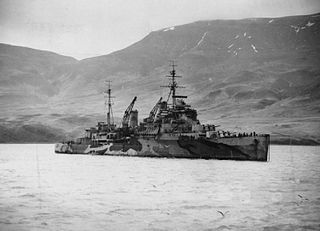
HMS Trinidad was a Royal Navy Fiji-class light cruiser. She was lost while serving in the Arctic on convoy duty after being damaged escorting PQ 13 in 1942.
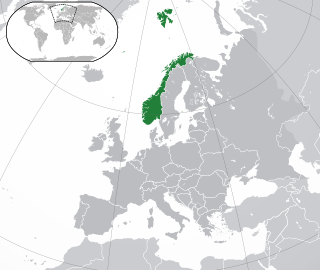
Convoy PQ 16 was an Arctic convoy of British, United States and Allied ships from Iceland to Murmansk and Archangelsk in the Soviet Union during the Second World War. The convoy was the largest yet and was provided with a considerable number of escorts and submarines. QP 12, a return convoy, sailed on the same day
Convoy PQ 1 was the second of the Arctic Convoys of World War II by which the Western Allies supplied material aid to the Soviet Union in its fight with Nazi Germany. The convoy sailed from Hvalfiord in Iceland on 29 September 1941 and arrived at Archangelsk on 11 October 1941.

Convoy PQ 18 was an Arctic convoy of forty Allied freighters from Scotland and Iceland to Arkhangelsk in the Soviet Union in the war against Nazi Germany. The convoy departed Loch Ewe, Scotland on 2 September 1942, rendezvoused with more ships and escorts at Iceland and arrived at Arkhangelsk on 21 September. An exceptionally large number of escorts was provided by the Royal Navy in Operation EV, including the first escort carrier to accompany an Arctic convoy. Detailed information on German intentions was provided by the code breakers at Bletchley Park and elsewhere, through Ultra signals decrypts and eavesdropping on Luftwaffe wireless communications.

PQ 13 was a British Arctic convoy that delivered war supplies from the Western Allies to the USSR during World War II. The convoy was subject to attack by German air, U-boat and surface forces and suffered the loss of five ships, plus one escort vessel. Fifteen ships arrived safely.
MV Atheltemplar was a motor tanker built by Lithgows, Port Glasgow. She was launched on 15 April 1930, registered in Liverpool and operated by the United Molasses Co Ltd of London. She was transferred to Athel Lines on 1 January 1940.
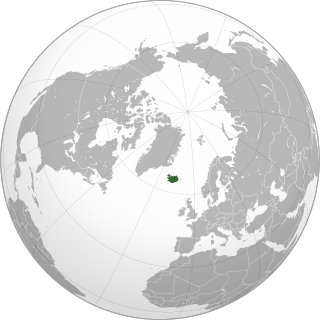
Operation FB took place as part of the Arctic Convoys of World War II. The operation consisted of independent sailings by unescorted merchant ships between Iceland and Murmansk. In late 1942, the Allies had taken the offensive against Germany but the dispatch of supplies to the USSR by convoy via the Arctic route was suspended, due to the demands of the Mediterranean campaign. Convoy PQ 19 was cancelled because the Home Fleet diverted ships to the Mediterranean for Operation Torch which would have had to be postponed for three weeks had ships been provided for PQ 19.

Convoy PQ 15 was an Arctic convoy sent from Iceland by the Western Allies to aid the Soviet Union during the Second World War. The convoy sailed in late April 1942, reaching the Soviet northern ports after air attacks that sank three ships out of twenty-five.
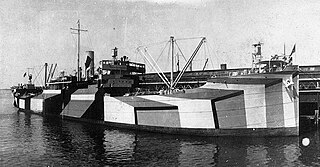
Convoy PQ 14 was an Arctic convoy sent from Great Britain by the Western Allies to aid the Soviet Union during World War II. It sailed in April 1942, reaching Murmansk after air and U-boat attacks that sank one ship, and ice damage that saw 16 vessels returned to port. Seven ships arrived safely.
Convoy PQ 12 was an Arctic convoy sent from Great Britain by the Western Allies to aid the Soviet Union during World War II. It sailed in March 1942, reaching Murmansk despite a sortie against it by the German battleship Tirpitz. All ships arrived safely.

Convoy PQ 8 was an Arctic convoy sent from Great Britain by the Western Allies to aid the Soviet Union during World War II. It sailed in January 1942 and arrived in Murmansk with the loss of one escort sunk, and one ship damaged.

Z7 Hermann Schoemann was a Type 1934A-class destroyer built for Nazi Germany's Kriegsmarine in the mid-1930s. The ship was plagued by machinery problems for most of her life and was under repair when the Second World War began in September 1939. She covered her sister ships over the next few months as they laid offensive minefields in English waters in late 1939 – early 1940. Hermann Schoemann played a minor role in the Norwegian Campaign as engine problems limited her availability throughout 1940 and for most of 1941.

Z24 was one of fifteen Type 1936A destroyers built for the Kriegsmarine during World War II. Completed in 1940, the ship spent the first half of the war in Norwegian waters. She was very active in attacking the Arctic convoys ferrying war materials to the Soviet Union in 1941–1942, but only helped to sink one Allied ship herself.

The Arctic Circle defining the "midnight sun" encompasses the Atlantic Ocean from the northern edge of Iceland to the Bering Strait in the Pacific Ocean. Military activity in this area between 1939 and 1945 is often considered part of the Battle of the Atlantic or of the European Theatre of World War II. Pre-war navigation focused on fishing and the international ore-trade from Narvik and Petsamo. Soviet settlements along the coast and rivers of the Barents Sea and Kara Sea relied upon summer coastal shipping for supplies from railheads at Arkhangelsk and Murmansk. The Soviet Union extended the Northern Sea Route past the Taymyr Peninsula to the Bering Strait in 1935.

Convoy QP 11 was an Arctic Convoy of World War II, made up of merchant ships returning from the Soviet Union to Britain after delivering their cargo to the Soviet Union. The convoy consisted of 13 merchant ships, escorted by 18 warships. The convoy was attacked by German destroyers and submarines, suffering the loss of one merchant ship as well as the light cruiser HMS Edinburgh. The German forces lost the destroyer Z7 Hermann Schoemann.

QP 14 was an Arctic convoy of the QP series which ran during World War II. It was one of a series of convoys run to return Allied ships from Soviet northern ports to home ports in Britain. It sailed in September 1942 from Archangel in Russia to Loch Ewe in Scotland.
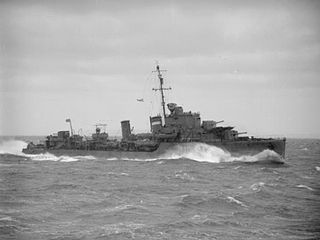
Convoy QP 13 was an Arctic convoy of the PQ/QP series which ran during the Second World War. It was the thirteenth of the numbered series of convoys of merchant ships westbound from the Arctic ports of Arkhangelsk and Murmansk to the United Kingdom, Iceland, and North America.

Sokrushitelny was one of 29 Gnevny-class destroyers built for the Soviet Navy during the late 1930s. Completed in 1939, she was initially assigned to the Baltic Fleet before she was transferred to the Northern Fleet in late 1939. After the German invasion of the Soviet Union in June 1941, the ship laid several minefields in the White and Barents Seas. Sokrushitelny spent most of her service escorting the Arctic Convoys, run by the British to provide weapons and supplies to the Soviets, or providing naval gunfire support to Soviet troops along the Arctic coast. The ship only fired at a German ship one time, while defending Convoy QP 13 in early 1942. While escorting Convoy QP 15 in November, she sank during a severe storm after breaking in half. Most of her crew was rescued by other destroyers sent to her aid, although 52 crewmen were lost.

















